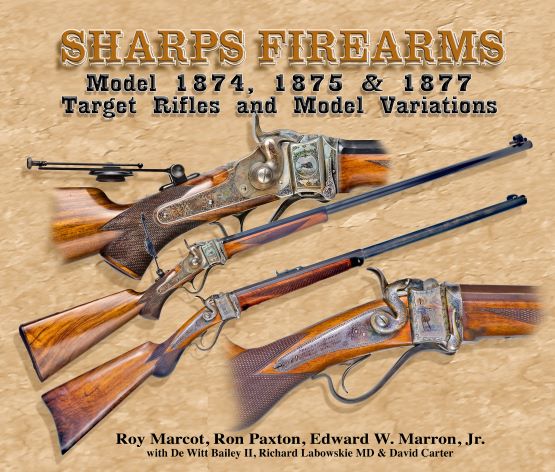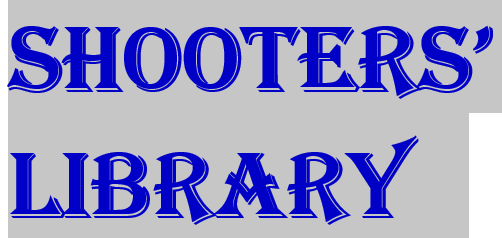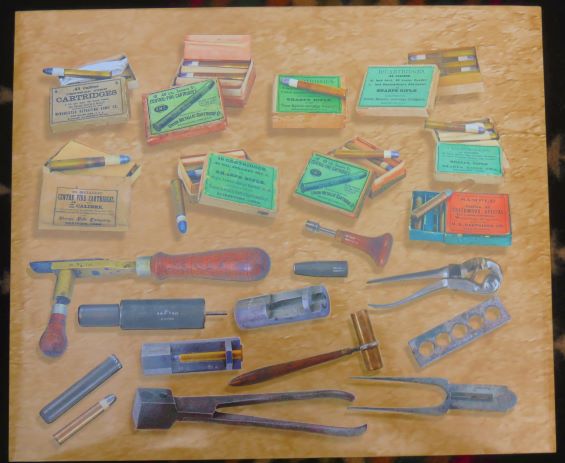
SHARPS FIREARMS, VOLUME lll
By Roy Marcot, Ron Paxton, and Edward W. Marron, Jr.
425pages, standard hardbound edition, $100.00
ISBN 978-0-9611494-8-2
The first thing I did, after receiving a copy to review, was to weigh it. This fine book weighs 6 ½ pounds! Its external dimensions are about 10 ¼” by 12 ¼” and it contains 425 pages. Those details simply add fuel to those who might judge this book by its cover but speaking of the cover, it is fantastic! So is the back cover. What I’m saying is, there’s a lot to see and that’s before even opening this book.

Of course, there is much more to see on the inside. Sharps rifle fanciers have known this book was coming for at least two years. It is the third volume in a four-volume series about the famous Sharps rifles. This volume is divided into 21 chapters. There are 13 chapters covering several specific versions of the Model 1874 Sharps rifles, one more chapter dedicated to the rare Model 1875 rifles, and 3 more chapters about the 1874 transition to 1877 rifles. That is followed by a chapter about the Freund Brothers and their alterations to Sharps rifles. Following that is one more chapter about other conversions and modifications to Sharps firearms which includes the famous Meacham conversions plus several by unknown gunsmiths. Then there are two more chapters; one about the Sharps metallic ammunition and the other about the Sharps reloading tools.
Chapter 7, about Heavy Barrel Model 1874 Rifles, drew me like a magnet. That’s where I started reading. This chapter contains the only mention of buffalo hunting and that portion of the chapter is rather short. What is mentioned much more are the heavy rifles made for benchrest shooting. Benchrest shooting evolved from the heavy muzzleloading “bench guns” and continued with the heavy breechloaders such as the Sharps. Of course, benchrest shooting and competition continues to this day, however, not particularly with black powder.
Old records were searched and those revealed that just over 200 of the Sharps rifles were made which weighed over 16 pounds! Those rifles were capable of some fantastic shooting and at least a very few of those targets have been preserved or recorded.
This book is dedicated to the target rifles and other variations of the Sharps rifles, in the Models of 1874, 1875, and 1877. (The buffalo rifles were covered in Volume II.) So, the famous Creedmoor rifles are given serious recognition as well as the Creedmoor matches. Those Creedmoor rifles had to meet very specific limitations to qualify, such as they couldn’t weigh over 10 pounds. Other target versions of the Sharps, like the “Long Range” rifles, were similar but without the weight restriction and the long-range versions could have double set triggers. The section about the Creedmoor matches includes photographs of the Creedmoor trophies as well as the shooting teams.

Also mentioned in detail is how the old Creedmoor matches, as well-known as they were, came to an end. In 1880 the governor of New York believed there would be no more wars, never again. So, he forbade the National Guard from further shooting practice. Almost at the same time, the regular Army stopped participating in the NRA matches at Creedmoor over some dispute with the NRA. Then the NRA deeded the Creedmoor range to the state of New York and then state officials either dropped or changed the entry fees for competitions, which ended the financial support for the Creedmoor matches.
What a nice world that governor lived in, a world with no more wars…
There are sporting models of the famous Sharps 1874 rifle included, in their own separate chapters. Those include the famous Business Rifle and, in another chapter, the Hunter’s Rifle. Another that gets a specific chapter are the “A” rifles. To continue just briefly about the versions of the Sharps 1874 that are covered, there are chapters on the 1874 Military rifles and another on the 1874 Military target rifles. This book certainly covers the 1874 rifles in details which have never been so completely available before.
Chapters that follow contain too much detail to completely discuss here. The subjects covered include the Model 1875 and also the “stepping stone” Pattern Rifles that led to the Model of 1875. A lot of history and development is mentioned here even though the Model 1875 never reached actual production. Few were made and that included one military version.
What was attempted with the 1875 as a target rifle was actually realized with the Model of 1877, a rifle with the weight in the action reduced so more weight could be added to the barrels. That I knew but I didn’t know how the Model 1877 was made in versions other than the Long Range or Creedmoor models. They also made, at least four, 1877s as mid-range rifles which had double set triggers. And there were sporting models among the 1877s as well. T hose were the rifles sent to J.P. Lower which have distinctions all of their own.
The final two chapters are all about Sharps ammunition and the Sharps reloading tools. Those chapters interest me greatly because they include information which hasn’t been covered nearly as completely as it is in this book. Obviously, for the followers of the Sharps rifles, this book has a lot to offer.
To get your own copy of SHARPS FIREARMS: MODEL 1874 TARGET RIFLES and MODEL VARIATIONS, VOLUME III, send $100.00, shipping is included, (with checks made payable to Northwood Heritage Press) to Roy Marcot, 4680 W. Placita Casa Sevilla, Marana, Arizona 85658. There is a limited supply of copies of SHARPS FIREARMS: THE PERCUSSION ERA, 1848 – 1865, VOLUME I still available for $100 from the same address. Volume II has sold out.
Volume IV, about the Sharps Model 1878, will be coming next.—Mike Nesbitt



